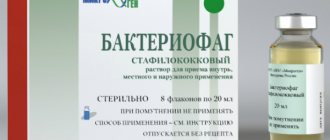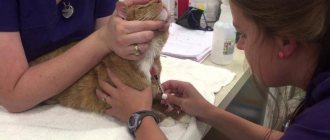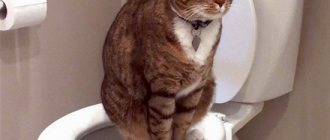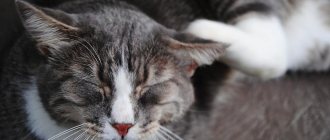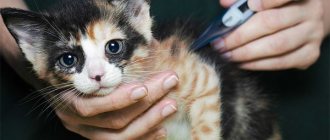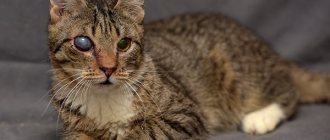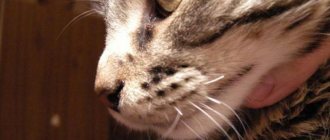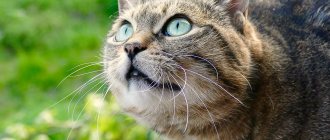7029Administration
The phenomenon of increased protein in a cat's urine is called proteinuria. Protein particles are small, they easily pass through the glomeruli and are therefore excreted along with the urine. If the urine contains protein in small quantities, then this is normal and a physiological process. When protein levels are elevated, this indicates health problems in the cat. In such a situation, it is important to identify the cause of the problem and provide quality treatment.
There are quite a lot of factors for the occurrence of a disorder, and only a veterinarian, after carrying out the necessary tests, will be able to determine why a cat’s urine contains increased protein. The disorder also occurs in dogs.
© shutterstock
Reasons for the appearance of large amounts of protein
Significant changes in the composition of urine, in which the protein level increases, occur for various reasons and negatively affect the general condition of the animal. This organic substance, washed out of the body along with urine, is also found in the blood. Problems with its release are the main indicator of damage.
The main causes of protein in a cat’s urine include:
- the presence of systemic diseases in the body (lupus erythematosus, which affects the kidney);
- chronic bacterial infections that spread to the urinary and circulatory systems;
- infectious diseases, for example, erilhoz or Lyme disease;
- diabetes mellitus, which mainly affects older cats
- pathologies of the pituitary gland, including Cushing's disease;
- long-term high blood pressure - hypertension appears not only in humans, but also in cats, in most cases in those over 10 years old;
- hereditary factors that negatively affect urine production;
- inflammatory processes in the kidneys, including urolithiasis;
- long-term problems with the production of carbohydrates and proteins in the cat’s body, which leads to serious problems with the functioning of the amyloid organ.
- inflammation of the circulatory system is a common reason why an animal has an increased content of organic matter in its urine;
The older your pet is, the higher the risk that it will develop problems that cause the amount of protein in its urine to increase.
Crystalline precipitation
Sperm
During catheterization, a small amount of sperm may be released into the urine. There is no deviation in this; all this data can be seen on the overall final analysis table.
Epithelial cells
The urine may contain a small amount of flat cells; the content of other cells is already considered a deviation from the norm.
Fat
In general, there should be no fat in the urine, but if a drop of fat is found in the daily dose of urine, then this is not a pathology. But if there is much more fat, then this indicates a metabolic disorder in the pet. In this case, treatment at a veterinary clinic is required.
Leukocytes
At 400x magnification, 0 to 3 cells should be visible on the microscope. If there are more of them, then such a deviation is called leukocyturia, and if their number exceeds 50, then pyuria. This type of urine is dark brown in color and smells like pus.
Urinary cylinders
Normally, urinary casts should not be present in urine. If such a deviation is observed, this indicates that the urine is too alkaline. Therefore, it is able to flush out the urinary ducts.
Vitamin C
By the amount of vitamin C, you can determine how things are with vitamins in the cat’s body. A daily dose of urine contains approximately 50 mg of vitamin C.
Bacteria
If the cat is healthy, then the urine should be sterile. If bacteria are present, it means there is inflammation in the genitourinary system.
Slime
Mucus in urine is contained in small doses. Its amount can increase during inflammatory processes in the body.
Mushrooms
Sometimes cats may have yeast in their urine when tested. They can enter the body along with anticancer drugs.
Diagnostic measures
If a pet is suspected of having proteinuria, the veterinarian will prescribe comprehensive treatment. But before doing this, the specialist will conduct the necessary diagnostics. It includes:
- Research on the amount of carotene.
- Urine analysis for protein levels. Its decoding is carried out by a specialist who helps to identify the content of the substance and its overall density.
- Pressure level measurement.
- Conducting a blood test that helps determine the overall physical condition of the pet. The information received is deciphered in the laboratory or by the veterinarian himself.
- Detection of creatinine, protein, in cat urine using biochemistry.
If necessary, the veterinarian prescribes additional diagnostics, for example, ultrasound and general urine examination, which help identify stones in the body. All important tests and examinations are determined by the doctor who is treating the animal. When the norm of protein in a cat’s urine is the upper limit, there is no point in talking about any disease. This is acceptable, therefore, with such indicators, there cannot be pathology.
Prevention
To prevent the formation of struvite in the urine of cats, veterinarians recommend following a number of simple rules. The most basic of them is organizing a balanced diet and drinking regime for the animal.
If your pet eats homemade food, focus on boiled meat, fish and vegetables; periodically use ready-made medicated food to replenish the diet with essential minerals. It is not recommended to give cats sausages, fatty meats, strong broths, or a lot of dairy products. When feeding your cat canned food or dry kibble, you should choose premium or super premium class food; they contain all the substances necessary for the cat’s body, and do not contain harmful preservatives, flavors and flavoring additives. Fresh water for the cat should be available around the clock.
Measures to prevent the formation of struvite in the urine of cats also include an active lifestyle. Provide your pet with the opportunity to run, jump, and play, even if he constantly lives in the house and does not go outside. A fat cat who spends all his time on the sofa or rug is much more at risk of developing ICD than a playful, active cat.
Struvite stones form more easily if the animal rarely empties its bladder. And since cats are clean and avoid using a dirty toilet, do not forget to change the litter in the tray on time. To fully ensure that your pet is healthy, have a veterinarian checkup twice a year, which includes a urine test.
Video advice from a veterinarian:
how to properly collect cat urine for analysis
- The cat can't go to the toilet
- Urolithiasis in cats (UCD)
- Kidney failure in cats
Main symptoms of damage
The main difficulty is that increased protein in a cat’s urine is accompanied by distinctive symptoms that are similar to many diseases. Because of this, making an accurate diagnosis can be quite difficult. Signs that indicate the presence of high levels of protein in the urine may include the following:
- complete or partial lack of appetite in the animal;
- regular nausea and vomiting in cats;
- rapid weight loss;
- malaise, sick appearance;
- apathy, deterioration.
After the first signs of problems in the animal have been identified, it is important to immediately visit a veterinarian, who will help make an accurate diagnosis and carry out effective and correct treatment before the condition becomes more complicated. Sometimes, when the amount of protein in a cat’s urine is greatly exceeded, the question of euthanasia may arise. Since this procedure helps to avoid the pet’s suffering, there is no other choice. As you can see, an excessive excess of organic matter in urine is a rather dangerous condition that is important to treat in a timely manner.
Types of proteinuria
This term refers to high levels of protein substances in urine. It is used to monitor kidney function. There are the following types of proteinuria. Mild - is not a harbinger of disease and occurs due to natural causes. Moderate and severe - these types indicate problems in the functioning of the kidneys. In these cases, in addition to protein in a 24-hour urine test, there are symptoms such as:
- bone pain;
- dizziness;
- loss of appetite;
- drowsiness;
- nausea;
- vomit;
- severe fatigue.
READ Green gecko how to care
Reasons for the appearance of protein in urine:
- heart failure;
- diseases of the central nervous system;
- hyperthyroidism;
- infective endocarditis.
A change in the composition of urine is indicated by its shade; the appearance of a whitish color is a sign of the presence of albumin, a protein substance.
The main factor influencing the appearance of protein compounds in urine is problems in the absorption of this substance. Proteinuria is distinguished:
- Canalicular. In some diseases, protein absorption is impossible or difficult.
- Glomerular. In this case, protein molecules are not retained and are excreted along with the liquid. This phenomenon is typical for the following pathologies: pyelonephritis, kidney damage from toxins, glomerulonephritis.
- Extrarenal. There are damage to the urinary tract, characteristic of urethritis, colpitis and cystitis.
To determine the type of proteinuria, microscopic examination is used. Further, if necessary, the doctor prescribes other types of examinations, including ultrasound, magnetic resonance imaging and other hardware methods.
Proteinuria can be divided into two types:
- Physiological (occurs due to strong activity of the animal or hypothermia of its body). In this case, the protein in the urine does not exceed 0.3 g/l.
- Pathological appearance (indicates the presence of serious health problems). The amount of protein in the urine exceeds the normal level.
Therapeutic measures
Let's see what measures specialists usually take when detecting protein in a cat's urine. Treatment begins immediately after the exact cause of the illness is established. In this case, it is important to determine whether proteinuria is oncological in nature. If a problem with the amount of protein in an animal’s urine occurs due to kidney cancer, then treatment will be effective only in the early stages of the disease. If the process has already reached a serious stage, then the pet can only be helped with supportive therapy, as well as the use of medications to eliminate pain.
If a specialist determines that a cat has problems with blood pressure, then he is prescribed a restorative course of treatment using special means. Your pet may also need a change in diet, from which salt and fats should be excluded. At the same time, to restore the animal’s body and improve its condition, medications with omega-3 fatty acids are prescribed. The supplement should be given to your cat daily.
Progress of treatment
It is important that the animal owner closely monitors the progress of treatment and the condition of his pet. He must also follow all the veterinarian's recommendations. The owner's caring approach greatly contributes to the animal's recovery and helps bring protein levels back to normal.
As a result of the course of treatment, the cat may experience swelling. In this case, it is important to show him to the veterinarian without fail. The doctor, having determined how much protein is contained in the urine, will formulate the correct and effective treatment and prescribe medications that will help eliminate excess fluid from the animal’s body. With timely treatment, the pet can live normally for many more years.
Protein levels in urine
A general urine test is a basic laboratory test that is prescribed to determine the functioning of the kidneys, the condition of the urinary tract and all processes that occur in the body. The information obtained as a result helps to make an accurate diagnosis and identify the general nature of the disease. Laboratory examination is prescribed if a disease of the urinary system, diabetes mellitus is suspected, as well as to monitor the course of the disease.
The main indicator in urine analysis is the amount of protein. Normally, a healthy animal should have no more than 0.3 g/l. The loss of organic matter should be minimal. The test result is considered normal when either the complete absence of protein or its minimal amount is determined in the urine. If there is too much of it in the urine, then the doctor may prescribe an additional examination, including an analysis of the ratio of protein and creatinine in the cat’s urine. At the same time, the daily indicators of excreted organic matter are determined.
The essence of the study
The protein concentration in a urine sample is determined using various techniques. The most common of them is the addition of special chemical reagents that cause denaturation of protein compounds. At
In this case, a white ring forms at the border of the urine and the reagent (the reagent is layered on the urine in the test tube). Based on the dilution factor of urine at which a thin ring of denatured protein is formed, its concentration is calculated. The amount of protein excreted during the day (daily proteinuria) is determined in a urine sample collected over a 24-hour period.
In modern laboratories, this research is carried out using special analyzers that give a more accurate quantitative result.
Determining daily proteinuria allows you to assess the functional state of the glomerular apparatus of the kidneys, which filters blood (formation of primary urine). With various pathologies, the biological (semi-permeable) membrane becomes inflamed and damaged, which leads to the passage of protein molecules through it.
- A preventive study to determine the functional state of the kidneys (it may also include the Zimnitsky test).
- Diagnosis of various kidney diseases accompanied by the excretion of proteins, in particular autoimmune inflammation (glomerulonephritis) with damage to the glomerular apparatus.
- Oncological process with the formation of a malignant tumor of the kidneys or other localization.
- Detection of an infectious process in the kidneys (pyelonephritis) or structures of the urinary system, while protein appears in the urine due to increased mucus production and the appearance of leukocytes in the urine.
Also, this study is carried out in doubtful cases when other diagnostic methods do not give reliable results.
Due to the fact that changes in the qualitative and quantitative composition of urine begin earlier than the symptoms of the disease, the analysis allows timely detection of pathology. Indications for this type of research in adults and children are the presence of the following diseases:
- amyloidosis (protein metabolism disorder);
- diabetes mellitus;
- nephropathy, which manifests itself as swelling of the legs;
- cardiac ischemia;
- renal failure.
In addition, it is prescribed when the patient is taking certain medications: aminoglycosides, ACE inhibitors, thiazide diuretics and some other drugs.
Types of pathology
The pathological type of proteinuria is divided into the following types:
- prerenal (damage to muscle tissue, multiple myeloma, hemolysis of red blood cells);
- postrenal (urethritis, cystitis and colpitis);
- glomerular (infectious processes, exposure to allergens, hypertension);
- tubular (interstitial nephritis, acute tubular necrosis and amyloidosis).
It is important to remember that an increased concentration of protein in an animal’s urine can be associated with both problems in kidney function and serious diseases. In some cases, poor tests result from improperly collected urine. Collection should be carried out according to special instructions given by the veterinarian.
additional information
In addition, if an animal has an increased protein content in its urine, then it is important to additionally pay attention to the transparency of the excreted urine. The thing is that it has the property of becoming cloudy in the presence of certain impurities in it, which include not only leukocytes, but also salts.
If there is a salty sediment in the urine, the animal can accurately determine urolithiasis, which in most cases affects cats. Pets who have previously been neutered are at risk. This can be explained by the fact that a sharp decrease in activity as a result of this type of operation leads to a sedentary lifestyle and overeating of the animal, which most often occurs when a certain diet is not followed.
